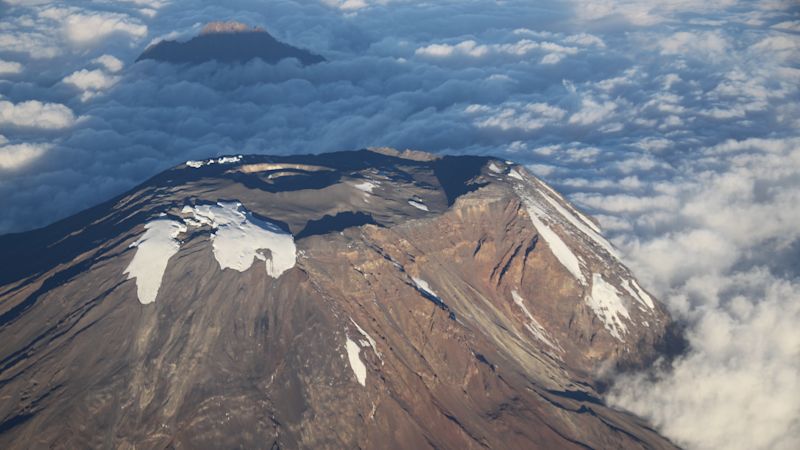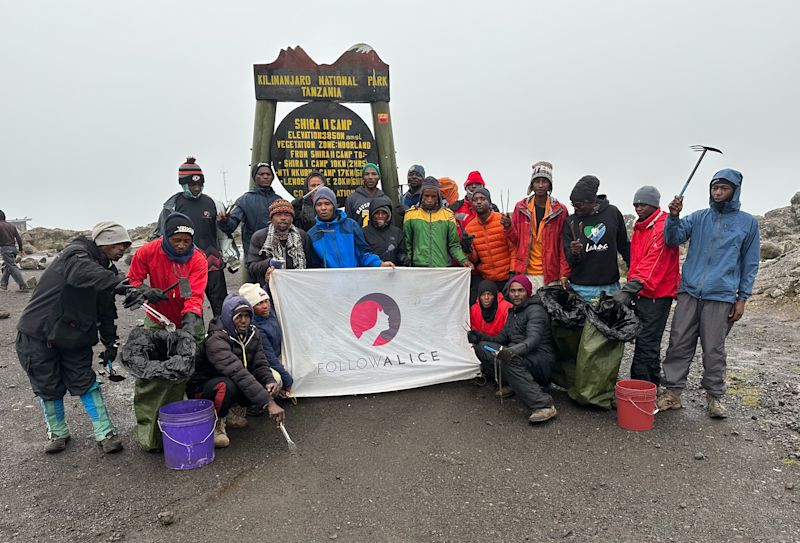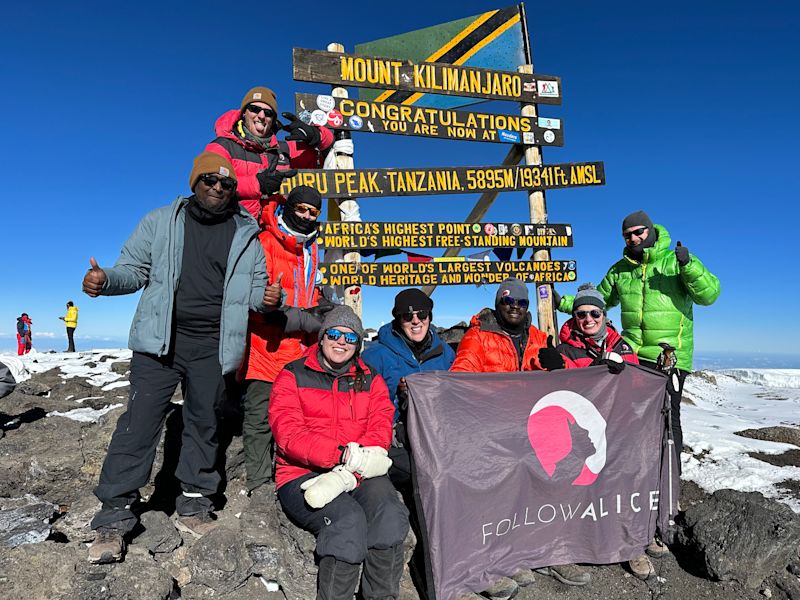East Africa's Mount Kilimanjaro and Mount Kenya are Africa's two highest peaks, so naturally adventurers from around the world are always heading to both to tackle their summits. The two mountains are only 320 km (200 mi) apart, and consequently have many similarities. Yet they also present some striking differences, especially in terms of the challenge involved in summiting each one. Here's all you need to know about Mount Kenya vs Kilimanjaro ...
Mountain locations
Map showing locations of Mt Kilimanjaro and Mt Kenya in East Africa
Mt Kilimanjaro sits in northern Tanzania, right on the border with Kenya. The upper part of the mountain is protected by Mount Kilimanjaro National Park. You can drive to Mt Kilimanjaro from Kilimanjaro International Airport in the nearby city of Arusha in under two hours.
Mt Kenya sits in central Kenya. Its upper portion is protected by Mount Kenya National Park. You can drive to Mt Kenya from Nairobi's Jomo Kenyatta International Airport in about three hours.
Both mountains are UNESCO World Heritage Sites.
Mountain profiles
Both Mt Kilimanjaro and Mt Kenya lie within the Great Rift Valley. Consequently, both mountains were shaped by past volcanic activity. While Mt Kenya is an extinct volcano, Mt Kilimanjaro is only dormant.
Profile of Mount Kilimanjaro
Mount Kilimanjaro has three volcanic cones that sit in a rough line and are connected by bridges of land. The tallest cone is located in the centre. The three cones are:
- Kibo (5,895 m or 19,431 ft) – this is the cone Mt Kilimanjaro trekkers climb
- Mawenzi (5,149 m or 16,893 ft)
- Shira (4,005 m or 13,140 ft)
The base area of Mt Kilimanjaro is around 388,5 km sq.
Profile of Mount Kenya
My Kenya has a far larger base than Mt Kilimanjaro – about double its size. Figures vary depending on exactly where you measure, but the diameter of Mt Kenya's base is roughly 120 km (65 mi) while the diameter of Mt Kilimanjaro's base is roughly 65 km (40 mi).
Mt Kenya two main peaks are only 650 m apart and are very similar in altitude:
- Batian (5,199 m or 17,057 ft)
- Nelion (5,188 m or 17,021 ft)
Mountain elevations
Kilimanjaro's Uhuru 'Peak' is the highest point on its crater rim
The highest point on Mt Kilimanjaro is Uhuru Peak (5,895 m or 19,341 ft), the highest point on the crater rim found atop Kibo Cone, the central volcanic cone of Kilimanjaro.
The highest point on Mt Kenya is Batian Peak (5,199 m or 17,057 ft). Batian is a more traditional (aka 'pointy') peak. And this is why it's harder to summit, as we discuss below.
Climb difficulty
While Mt Kilimanjaro is the higher mountain, its highest point (Uhuru Peak) is a non-technical trekking peak. So ordinary hikers can actually summit Mt Kilimanjaro. That said, the extreme altitude of the mountain should never be underestimated, especially by those who've never tackled a high-altitude climb before.
My Kenya's highest point (Batian Peak), on the other hand, is a technical climbing peak. So you need mountaineering equipment and experience to reach it. Batian Peak is the highest mountaineering peak in Africa. If you ascend to the peak via the North Face Standard Route, you're in for a IV+ grade climb. If you ascend via the South-West Ridge Route, you're in for a IV grade climb.
It's worth pointing out that Mt Kilimanjaro's second-highest peak, Mawenzi, is a technical climb. Also, Mt Kenya's Lenana Point (4,985 m or 16,355 ft) is a popular non-technical trekking peak. So both mountains offer exciting and rewarding technical and non-technical climbs.
Fitness required
For either mountain, you need to be able to trek uphill for a handful of back-to-back days and then have the knees for a long downhill. So good hiking fitness is crucial. (Note that there are no rest days on either mountain.)
To climb Batian Peak you also need to be able to handle a day-long summit climb that involves about two dozen pitches. Of course, all of this must be done at high altitude, making it even tougher. So good climbing fitness is required.
On a Mt Kilimanjaro climb you don't need to do any climbing, as previously discussed. But you do require even greater endurance than you do for a Mt Kenya climb (or Point Lenana trek), as a Kilimanjaro trek is always going to be longer by about two days. You can learn more in What is the best training for Kilimanjaro?
Climate
Climate infographic for Mt Kilimanjaro and Mt Kenya
Both Mt Kenya and Mt Kilimanjaro are close to the Equator. Once you start ascending either mountain, you encounter similar, concentric climate bands.
The different climate bands on both Mt Kilimanjaro and Mt Kenya are as follows, starting at the mountain base:
- A subtropical region
- Afro-montane forest, which includes bamboo stands and mixed rainforest
- Afro-alpine moorland (or heather)
- Alpine desert, where very little grows
- An arctic summit, which includes glaciers and seasonal snow
Flora and fauna
Giant groundsels can be found on both mountains
The wildlife and vegetation of both mountains are quite similar given their proximity, similar altitudes and similar climate bands.
For instance, both Mt Kenya and Mt Kilimanjaro have especially striking and rare Afroalpine moorland vegetation, which includes giant lobelias and giant groundsels. There's also a highly rare, red-and-yellow flower that grows nowhere in the world except in the rainforest of Kilimanjaro: the Kilimanjaro impatiens.
The bases and surrounding plains of both mountains are home to large game like elephants, Cape buffaloes, elands and leopards. Higher up on both mountains you can find some shared animal species like servals, hyraxes, colobus monkeys, blue monkeys, baboons, aardvarks, duikers and rare Abbott's starlings.
Mt Kenya does, however, have some endangered and rare species that Mt Kilimanjaro does not have, like sunni bucks, albino zebras and Mount Kenya mole shrews. Mt Kilimanjaro, on the other hand, has one notable species not found on Mt Kenya: Jackson's chameleons.
Weather and trekking conditions
Mt Kenya and Mt Kilimanjaro have similar seasons
The weather varies by season and climate band on both Mt Kenya and Mt Kilimanjaro. But since both mountains are very close to the Equator (Mt Kenya actually straddles the Equator), temperature variations between the seasons aren't immense. That said, the seasons on both mountains are as follows:
- The short dry season (mid December to mid March) – snow usually falls on the summits, which is very pretty, though you could have zero visibility if you summit during snowfall
- The long wet season (April and May) – expect lots of cloud cover and mist in the forest and moorland bands, and possibly slippery trails
- The long dry season (June to mid October) – generally clear skies and good visibility from the summit, but also coldest summit temperatures
- The short wet season (November) – mountain crews usually do trail maintenance on Kilimanjaro during this month
Note that it can be hot and sticky in the forest band at any time of the year. Also, night-time temperatures in the alpine desert and arctic zones are usually always below freezing point.
On a Mt Kilimanjaro summit, you don't need to cross any of its glaciers. In fact, at certain times of the year you won't even step on any snow or ice during your trek. (If you're interested in learning more, please read When is there snow on the summit of Kilimanjaro?) On a Mt Kenya summit, on the other hand, you have to navigate your way across ice and glaciers (or glacier remnants), no matter which route and time of year you climb.
Peak seasons
Climbers near the summit of Mt Kenya
The best time to climb Mount Kilimanjaro or trek to Point Lenana on Mount Kenya is during either of the dry seasons, so that means mid December to mid March or June to mid October. The dry seasons offer better trekking conditions, such as clearer summit views and less slippery forest trails. This means the dry seasons are also the peak seasons. The busiest season, however, is June to October, is this coincides with the summer holidays in the northern hemisphere.
Note that you can trek either mountain at any time of the year, as they're never shuttered, so to speak.
The shoulder seasons are good options if you'd prefer a less crowded trail. Though the best way to avoid any crowds, even in peak season, is to choose a quieter route, like the Northern Circuit or Rongai route on Kilimanjaro.
The best time to summit Batian Peak on Mt Kenya is July to September if you wish to ascend the north face. If you wish to summit via the south face, then the best time is December to February.
Routes
There are nine main routes on Mt Kenya, used by those intending to climb Batian Peak as well as by those trekking to Point Lenana. The three most popular routes are as follows:
- The Naro Moru route, a steep and direct path that leads up the southwest slope.
- The Sirimon route, a slightly longer and gentler route that leads up the northwest slope.
- The Chogoria route, which is on the eastern slope and is mostly used as a descent route.
As already mentioned, if you wish to summit Batian Peak, the most popular climb route is the North Face Standard Route.
On Mt Kilimanjaro, on the other hand, there are seven ascent routes and two descent routes. The most popular routes are as follows:
- The Lemosho route heads up the western slope of the mountain.
- The Machame route, the most popular, heads up the southwest slope.
- The Marangu route, the original trail, heads up the eastern slope.
- The Mweka route is a descent-only trail and is used by most trekkers.
Accommodation
Shipton's Camp on Mt Kenya
On Mount Kilimanjaro, most trekkers stay in tented camps. In fact, camping is the only available option except on the Marangu route (also known as the Coca Cola route), where there are permanent huts. All campsites are overseen by the Kilimanjaro National Park Authority (KINAPA), and so facilities (like simple ablution blocks) are the same. Whichever route you choose, you can only overnight in the designated campsites.
On Mt Kenya, you can camp wherever you choose. If you don't want to camp, know that most of the mountain huts are privately owned. This means there's variety in terms of the facilities and prices of the different cabin accommodations on Mt Kenya.
Duration
Given its significantly lower summit altitude, Mount Kenya is the shorter adventure. A Mt Kenya adventure usually takes four to six days, while a Mt Kilimanjaro adventure usually takes six to eight days.
But remember that both mountains have more than one route leading to and from the summit, so there's no fixed route and hence no fixed duration. Everything depends on your choice of route and how long you choose to take over the ascent and descent.
We would like to point out that altitude sickness is a very real danger on both treks, and you would be wise to give yourself a little longer over the ascent in order to minimise your chances of developing this potentially life-threatening illness.
Tour operators and guides
Follow Alice trekkers with some of their mountain crew on a Kilimanjaro climb
You might have already picked up on that the fact that pretty much everything to do with a Mt Kilimanjaro climb is more established and formalised than it is for Mt Kenya. And the same goes for the rules and regulations surrounding a climb.
On Mt Kilimanjaro, everyone must trek with a tour operator (like Follow Alice) as per a ruling from KINAPA. This helps to ensure that all treks benefit the local economy. The ruling also helps to ensure trekker safety, as every group must be assigned at least one trek guide.
On a Mt Kenya climb, however, it's not mandated that you climb with a tour operator (and hence a guide). That said, it's strongly recommended that you do sign up with a tour operator.
Please note that a trek guide makes your life far easier from an admin point of view. Moreover, while the trekking routes on both mountains are well-marked, there's still the possibility of becoming lost, especially in bad weather. Mountain guides are also crucial in monitoring your health, providing first aid if necessary, and offering valuable tips and encouragement.
Crowds
Mt Kenya National Park sees far fewer visitors than Mt Kilimanjaro National Park. The two main reasons for this are that Mt Kilimanjaro has the allure of being Africa's tallest peak and it can be summited by regular hikers (since no technical expertise is required).
According to the Kenya Wildlife Service, as of 2006, only about 50 to 100 mountaineers attempt to climb Batian Peak each year, and roughly 200 attempt to climb Nelion Peak. Around 15,000 trekkers a year head for Point Lenana.
Figures are actually hard to come by for Mt Kilimanjaro, partly because the sheer volume of people trekking with the various tour operators makes it hard to keep any decent headcount. That said, it's been estimated that around 50,000 attempted to summit Mt Kilimanjaro each year before the coronavirus pandemic. As of 2024, we can say that trekking figures are about normal again for Mt Kilimanjaro.
All of this means that the 'crowd' of high-altitude trekkers on Mt Kenya is about 30% the size of that on Mt Kilimanjaro.
Summit success rates
A Follow Alice group celebrating at Uhuru Peak on Mt Kilimanjaro
A summit success rate is the percentage of people who set out for a mountain's summit and actually manage to reach it.
There are no official summit success rates for either Mt Kenya or Mt Kilimanjaro. And tour operators sometimes inflate their own summit success rates for marketing purposes, so it would be hard to gauge accurate figures if you were to canvass that way.
What we can say is that the longer you take for the ascent of either mountain, the higher your likelihood of reaching the summit. This is because you allow yourself more to acclimatise more, which is important in avoiding altitude sickness.
If we were pushed for a figure, we'd estimate that about 60% of Mt Kilimanjaro and Mt Kenya trekkers actually manage to reach Uhuru Peak or Point Lenana when you consider all routes, itinerary durations and tour operators. For Batian Peak, the summit success rate can vary greatly year on year based on the skill and experience of the groups that attempt it, so figures here aren't really useful.
We hope you found this comparison of Mt Kenya vs Kilimanjaro helpful. At Follow Alice we don't offer Mt Kenya climbs at present, but we are highly experienced in leading Mt Kilimanjaro treks. Please check out the Kilimanjaro routes we offer if you might be interested in tackling this epic adventure with us!














